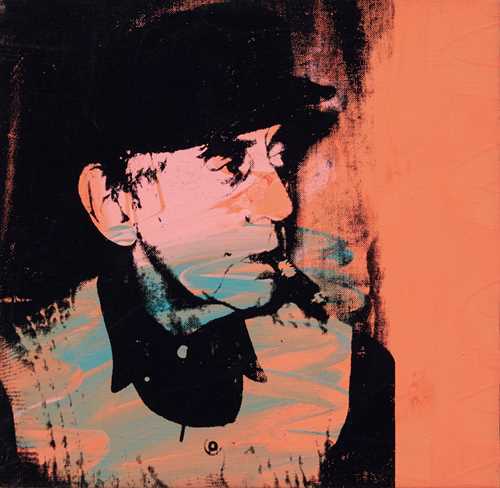
Lot 3430 - A205 PostWar & Contemporary - jeudi, 22. juin 2023, 14h00
ANDY WARHOL
Literature: Printz, Neil/King-Nero, Sally: The Andy Warhol Catalogue Raisonné. Paintings and Sculpture, Volume 3, 1970-1974, New York, 2014, no. 2660, p. 391 (with colour ill.)
Exhibition: Milan 1974, Man Ray by Andy Warhol. Galeria Il Fauno - Alexandre Iolas, October.
In the 1960s and 70s, Man Ray was represented by three of the most influential Italian art dealers - Giorgio Marconi, Arturo Schwarz and Luciano Anselmino - and achieved an extraordinary level of fame in Italy. This explains why Anselmino, who would later take over the famous gallery of Alexandre Iolas, commissioned Andy Warhol to do a series of portraits of Man Ray in 1973.
For Andy Warhol, whose œuvre dealt explicitly with contemporary society - from consumerism and celebrities to everyday objects and catastrophes - portraits played a major role. While the portrait series featuring Marilyn Monroe, Jackie Kennedy, Elizabeth Taylor, James Dean, etc. helped the Pop Art artist achieve world fame, he also devoted himself time and again to less glamorous personalities. For instance, many portraits were made of collectors such as the German Peter Ludwig, but also of important art dealers such as Alexandre Iolas and Bruno Bischofberger or fellow artists such as Joseph Beuys, David Hockney and, as in this case, Man Ray.
The photo session took place on 30 November 1973 in the Paris studio of the 83-year-old artist. Warhol divided the entire series into 2 large (80 x 80 inch), 6 medium (40 x 40 inch) and 20 small (13 x 13 inch) formats. In the small format works, from which the present piece is taken, the sitter is looking to the right, a cigar in the right corner of his mouth and a fishing cap on his head. Warhol worked the underlying colour silkscreen with acrylic paints in orange and a blueish green.
This particular portrait is a wonderful way of illustrating Warhol's concept of art and the approach he used to revolutionise art history: the subject is an artist who is "only" known in art circles, and yet a series of portraits is dedicated to him as if to a prominent personality. The principle of the series puts the uniqueness of the artwork into perspective, but also that of the sitter. The photo, taken with an ordinary Polaroid camera, served as the basis for the silkscreen, which was then in turn reworked. Warhol thus availed himself of technical possibilities, which made the work process very efficient and enabled him to hand over parts of the production. Then again, the individual processing creates unique pieces.
What is exciting about this series is the contrast between the two artists: the American, Man Ray, born in 1890, spent the most important part of his life in Paris and played a decisive role in shaping the advent of modernism. His love of experimenting with new techniques and art movements was boundless. Especially as a photographer, he tried out and refined every technical innovation. In contrast, Andy Warhol, born in 1928, spent most of his life in New York. He revolutionised art, but then remained true to his principle. For him, photography was a means to an end, for which a simple, inexpensive Polaroid camera was perfectly adequate.
CHF 100 000 / 150 000 | (€ 103 090 / 154 640)
Vendu pour CHF 146 700 (frais inclus)
Aucune responsabilité n'est prise quant à l´exactitude de ces informations.


